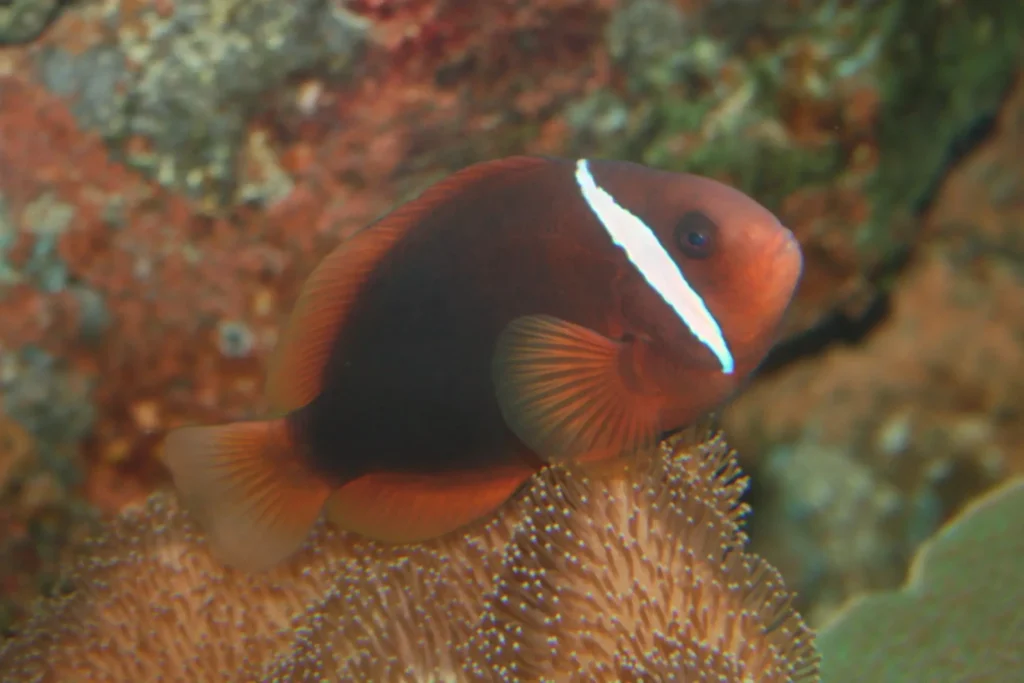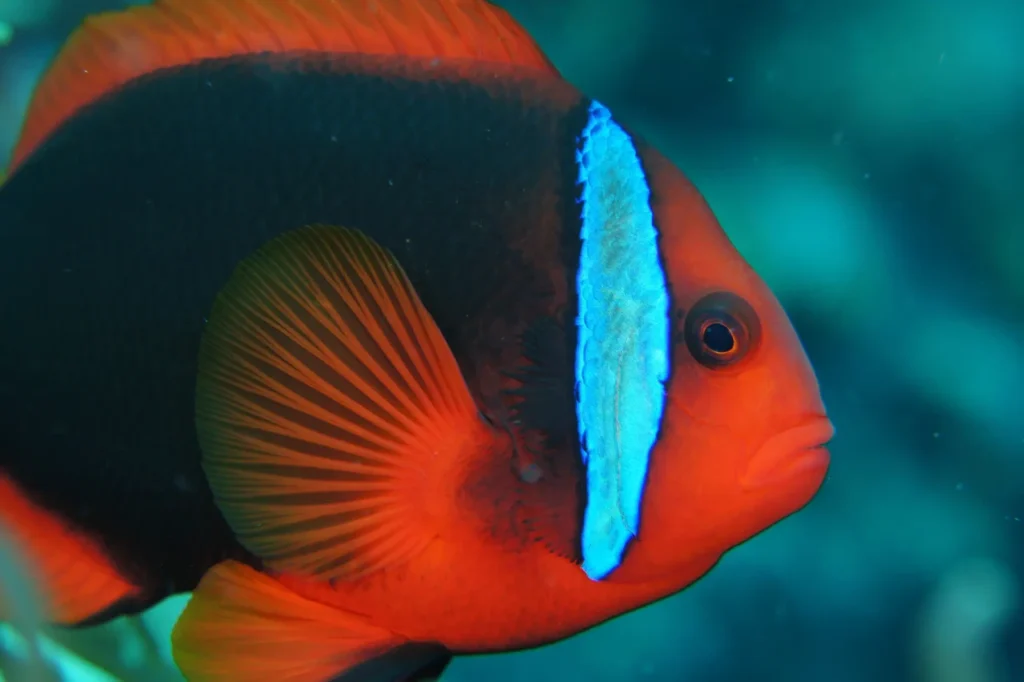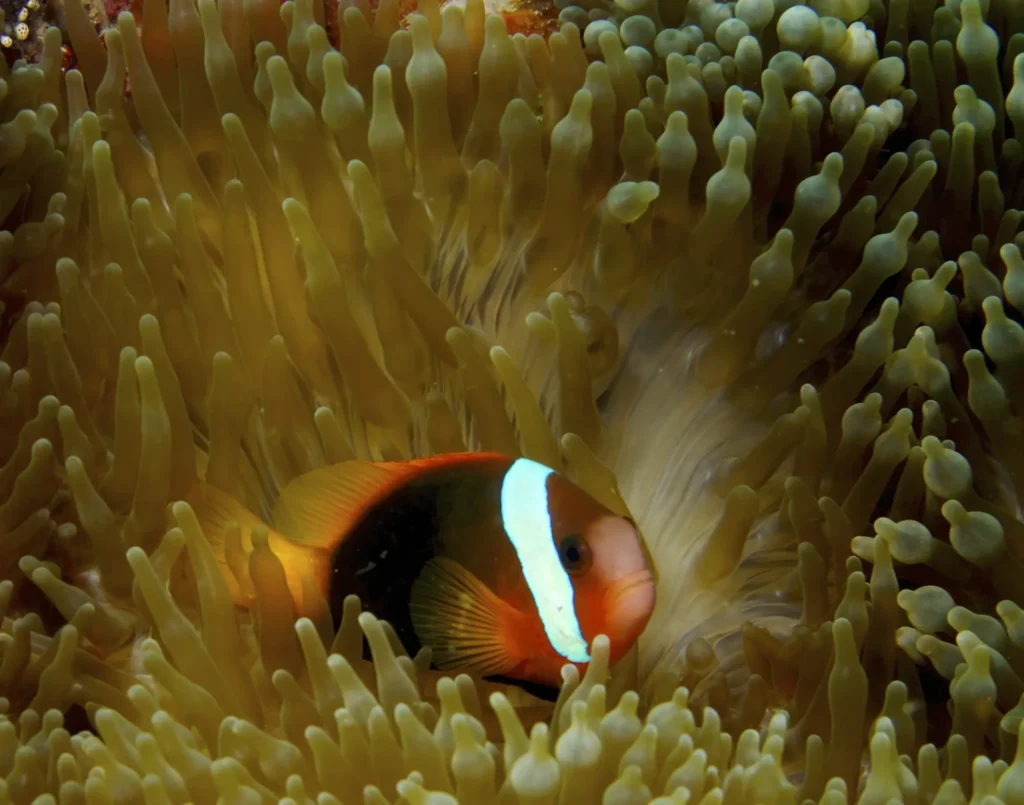Among the clownfish, there is a special species that impresses with its rich red color and unique character. Tomato Clown (Amphiprion franatus), or tomato amphiprion, got its name due to the bright red color, reminiscent of a ripe tomato fruit.
✔ Rich red or orange-red color
✔ One white stripe behind the eyes (often disappears in adults)
✔ It lives in symbiosis with anemones and actively defends its territory
✔ It is popular among aquarists because of its bright color and hardiness.
Let's dive into the world of this interesting fish!

Scientific classification
✔ The Kingdom: Animals (Animalia)
✔ Type: Chordal (Chordata)
✔ Class: Lucheperi pisces (Actinopterygii)
✔ Row: Perch-like (Perciformes)
✔ Family: Pomacentrovye (Pomacentridae)
✔ Gender: Amphiprion
✔ View: Amphiprion frenatus (Brevoort, 1856)
📌 Interesting!
Title frenatus it comes from Latin and means "equipped with a bridle", which may hint at a white stripe on the head of young individuals.
Appearance
🔹 Body shape:
✔ Oval, flattened on the sides
✔ Compact and well adapted for maneuvering among the tentacles of an anemone
🔹 Color scheme:
✔ Young fish: bright red with two white stripes
✔ Adults: deep red-orange color with one white stripe behind the eyes
✔ Black tints on the fins (especially in males)
🔹 Sizes:
✔ Average length: 8-10 cm
✔ Maximum length: up to 14 cm
📌 Interesting!
As they grow older, the white stripe becomes less pronounced or disappears altogether in females.
Range and habitat
🌍 Where does the tomato clown live?
✅ Western Pacific
, Southeast Asia, Philippines, Japan, Indonesia
✅ The Great Barrier Reef
🔹 Living environment:
✔ Coral reefs on the at depths of 1-12 meters
✔ Often found near rocks, coral colonies and anemones
📌 Interesting!
Unlike some other clowns, the tomato clown can inhabit in shallow waters off the coast.
Symbiosis with sea anemones
🔹 How does symbiosis work?
✔ The clown lives among the tentacles of the anemone, using it as a defense against predators
In return, he brings food to the anemone and cleans its tentacles
🔹 What kind of anemones does it co-exist with?
✔ Entacmaea quadricolor (bubble anemone) - the most common
✔ Heteractis crispa (Crystal Rose anemone)
✔ Stichodactyla gigantea (giant anemone)
📌 Interesting!
If a tomato clown is moved to another anemone, it takes time to develop protection from its stinging cells.

Lifestyle and behavior
🔹 Social structure:
✔ Lives in groups: dominant female, male and several young individuals
✔ The largest individual – female, the rest are males
🔹 Defensive behavior:
✔ Aggressive towards other fish in its anemone
✔ Can attack larger opponents if they approach its territory
🔹 Life span:
✔ In the wild: 6-8 years old
✔ In captivity: up to 12 years old
📌 Interesting!
If the female dies, the largest male changes sex and takes its place.
Nutrition and environmental role
🥗 What does the tomato clown eat?
✅ Small zooplankton
✅ Crustaceans
, Seaweed
🔹 Environmental role:
✔ Cleanses the anemone from food residues
✔ Controls the abundance of small marine organisms
📌 Interesting!
Clowns can even bring small food to the anemones, effectively "feeding" them.
Reproduction and development
🔹 Method of reproduction:
✔ Female lays eggs 200-600 eggs
✔ The male guards the clutch, ventilates the water around the eggs
🔹 Development:
✔ Larvae swim in the water column up to 2 weeks
✔ Juveniles settle among anemones after metamorphosis
📌 Interesting!
The larvae of clownfish are very sensitive to light, and their color appears only after settling on the bottom.

The Tomato Clown and the Man
🔹 Popularity in aquariums:
✅ Often found in marine aquariums
Вынос Hardy and less fastidious in care
🔹 Industrial value:
✅ Grown in nurseries for sale
📌 Interesting!
Due to its aggressive nature, this species is not recommended for keeping with other clownfish.
Species conservation and environmental threats
🔹 Population status:
✅ The species is not under threat
🔹 Main threats:
Ruinuvannya coral reef destruction
Zabrudnennya ocean pollution
Pitchfork catch for aquariums
🔹 Security measures:
✔ Captive breeding helps reduce pressure on natural populations
✔ Creation of marine reserves
📌 Interesting!
The industrial catch of clownfish has declined due to their successful breeding in aquariums.
Conclusion
🐠 Tomato clown (Amphiprion frenatus)-this is not only one of the brightest, but also one of the most interesting representatives of clownfish. Its fiery coloration, strong character and dedication to its anemone make it a true gem of coral reefs.
💡 Would you like to have such a reef guard in your aquarium? 🔥🌊✨